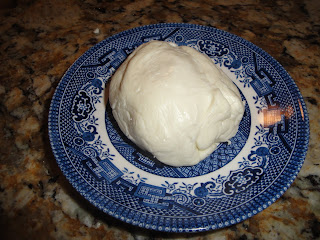Last night I tried my hand at making homemade mozzarella again. This time I used a full gallon and had a good thermometer that worked.
Here is my ingredient list this time:
1 Gallon Milk
2 tsp Citric Acid
1/4 tsp Rennet, diluted in 1/4 cup cold water
2 tsp salt
As you can see from the picture above I am also using rubber gloves, last time I learned that when you microwave the cheese it gets very hot. This recipe is suppose to take only 30 minutes, but for me it probably took closer to an hour, it may be because I am heating up the milk slower then I am suppose to or something.
First step was to mix the milk with the citric acid and warm it up to 88 degrees, at that point you put in the rennet and then warm it up to 105 degrees. I thought I was doing good at this stage until when I got needed to put in the rennet. The thermometer read 88 but when I moved it to put in the rennet it registered closer to 100, I guess my post is not doing a good job at warming the milk evenly. So I only had to leave it is a little longer and it was up to 105 but in some areas only up to 100. So I need to figure out the best way to get the milk to read close to the same temp no matter where in the pot it resides.
After it got to 105 I took it off the heat and let it sit for about 5 minutes. It look much more promising this time because I was able to get a clean break, this is where you can put your finger into it the curds and pull it out with out having a lot milk residue on your finger. Though it did not look quite like yogurt like it is suppose too.
I then scooped the curds out with a slotted spoon into a microwave safe bowl. I was able to get much more curds this time then last time. I then formed the curds into a lose ball and drained as much whey as I could. I then microwaved it for 1 minute removed it and formed the cheese into a ball again (this is where I needed the rubber gloves) and then draining off they whey. I did this two more times for only 30 seconds.
By this time the cheese had started to get more stretchy. I then started kneading it and pulling it. At this point I put in the salt. I was able to get a somewhat smooth ball of cheese that tasted very close to mozzarella. We ended eating it with some tomatoes with a basil and balsamic topping. I thought I had done okay but was a little disappointed that it only produced a rather small ball of cheese.


After I was done I searched the Internet for videos of people making mozzarella to see how much cheese they yielded from 1 gallon of milk. They seemed to get much more than I did and when they took the curds out it was in much bigger pieces then what I got. After some searching I think I might know what my problem was (at least I hope). I have been using Kroger milk and I think it has been ultra pasteurized. Which kills the living enzymes in the milk and allows m
ilk to keep fresh longer. So at 10:45 last night I ran out to the store to buy some milk that comes from a local dairy in hopes that it will work better. I will hopefully try that tonight


But back to what I did with all the whey left over from the mozzarella. I of course made some Whey Ricotta. I don't want to waste the milk. So I made it again much similar to the way I have before. I was able to get quite a bit of curds out of the whey and make a nice chunk of Ricotta. It tastes good and I ate some last nigh with some slices of tomatoes. This morning I also used some of the ricotta for breakfast. Look to a future post to see what I made for breakfast with the Ricotta.



